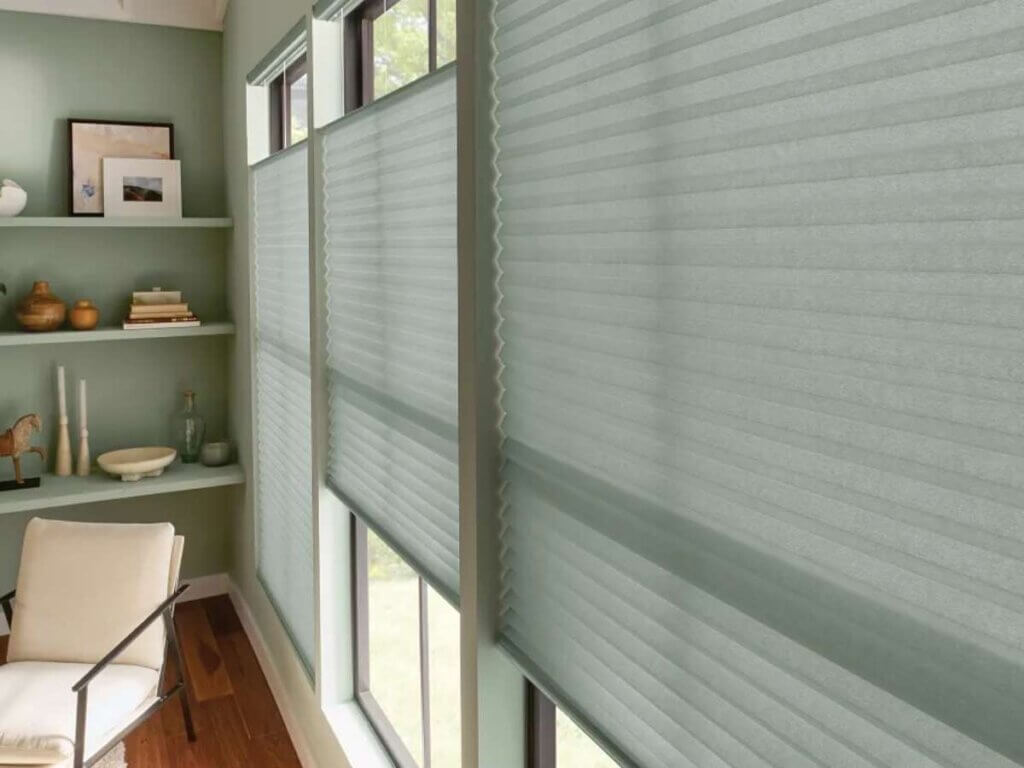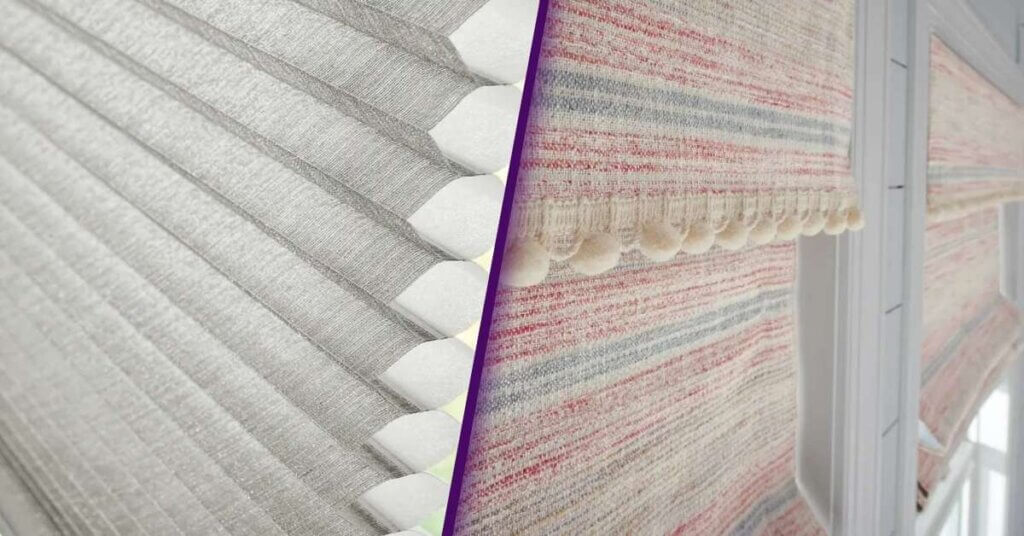When updating your window treatments, cellular shades vs. Roman shades is one of the most common comparisons homeowners face. Both styles offer unique advantages in style, insulation, light control, and design versatility, but understanding their distinctions can help you choose the best fit for your home. In this guide, we’ll explore how each type performs in terms of energy efficiency, privacy, fabric texture, and maintenance, so you can make an informed choice that aligns with your lifestyle and aesthetic preferences.
Let’s look closer at how these two popular window treatments differ—and which one may be the superior option for your space.
What Are Cellular Shades?

Cellular shades, also known as honeycomb shades, are designed with air pockets or “cells” that trap air, creating an insulating layer between your window and the room. This structure helps maintain indoor temperature, offering exceptional thermal performance and energy efficiency.
Their minimalist, structured appearance makes them ideal for modern interiors, while the variety of fabrics, pleat sizes, and light-filtering options allows them to fit seamlessly in any room. Available in cordless and motorized options, cellular shades offer convenience, safety, and style for both contemporary and classic homes.
What Are Roman Shades?

Roman shades bring timeless charm and soft texture to any room. Made from fabric that folds gracefully as the shade is raised, they introduce a touch of elegance and warmth. Their signature pleats and folds can be tailored for either a classic draped or modern streamlined appearance.
Roman shades come in a wide selection of materials, colors, and patterns, making them a favorite for homeowners who want a custom look. They can also be lined for room darkening or blackout capabilities, making them a practical and stylish choice for bedrooms, living areas, and home offices.
Design and Aesthetic Appeal
Roman shades are often chosen for their visual richness. The cascading folds add texture and depth, creating a design focal point in any room. Whether you prefer the softness of linen or the luxury of velvet, these shades elevate a space with their tailored craftsmanship.
In contrast, cellular shades embody a minimalist and modern aesthetic. Their clean, crisp lines suit homes with contemporary décor or smaller rooms where a streamlined look enhances the sense of space.
Verdict: If you prioritize texture and visual appeal, go with Roman shades. If you prefer a sleek and unobtrusive design, cellular shades are the better fit.
Energy Efficiency and Insulation
This is where cellular shades truly stand out. Their honeycomb design traps air within the cells, significantly improving insulation and reducing heat transfer. As a result, they help lower energy bills by keeping your home cooler in the summer and warmer in the winter.
Roman shades, while capable of offering some insulation—especially when lined—cannot match the thermal efficiency of cellular shades. However, thicker fabrics or a thermal lining can enhance their performance.
Verdict: For maximum energy efficiency and comfort, cellular shades are superior.
Light Control and Privacy
Both shade types offer excellent light control and privacy options, but their mechanisms differ.
Cellular shades can range from light-filtering to complete blackout designs, making them versatile for bedrooms or media rooms.
Roman shades, depending on the fabric, can provide gentle light diffusion or full room darkening. The addition of a blackout liner improves privacy and light blocking.
Both styles are available in cordless or motorized versions, ensuring a smooth, child-safe operation.
Verdict: It’s a tie—your choice depends on how much light you want to let in and the mood you wish to create.
Cost and Maintenance
When comparing cost and maintenance, cellular shades generally come out as more budget-friendly. They are lightweight, durable, and require minimal upkeep—usually just occasional dusting or vacuuming.
Roman shades, depending on the fabric and lining, tend to cost more due to the craftsmanship and materials involved. Their rich fabric folds may also need occasional spot cleaning or professional maintenance to keep them looking pristine.
Verdict: For affordability and easy maintenance, cellular shades are a practical choice.
Durability and Longevity
Both options are long-lasting, but cellular shades tend to resist wear better over time because of their structured materials and durable design. Roman shades, being fabric-based, may be more susceptible to fading or fraying, especially in areas with direct sunlight.
Verdict: For long-term durability, cellular shades hold the advantage.
Which Shade Should You Choose?
Your decision ultimately depends on your home’s needs and style preferences.
Feature | Cellular Shades | Roman Shades |
Design Style | Modern, minimalist | Classic, elegant |
Insulation | Superior energy efficiency | Moderate insulation |
Light Control | Light-filtering to blackout | Soft light to blackout |
Maintenance | Easy to clean | Requires more care |
Aesthetic | Crisp, structured look | Soft, layered appearance |
Price Range | Budget-friendly | Typically higher |
Durability | Long-lasting | Dependent on fabric |
Recommendation:
- Choose cellular shades if your top priorities are insulation, energy efficiency, and low maintenance.
- Choose Roman shades if you value elegance, texture, and custom design for a timeless look.
FAQs About Cellular and Roman Shades
1. Can cellular and Roman shades be installed together in the same home?
Yes. Many homeowners use both styles strategically—cellular shades for functional spaces like bedrooms or offices, and Roman shades for living areas or dining rooms where aesthetics play a larger role.
2. Are Roman shades or cellular shades better for room darkening?
Both can achieve effective room darkening. Cellular shades with blackout materials block light efficiently, while Roman shades with blackout liners can create a similar effect with a softer appearance.
3. Do cellular shades really help lower energy costs?
Absolutely. Their honeycomb design acts as a natural insulator, helping regulate room temperature and reducing reliance on heating or cooling systems. Over time, this can lead to noticeable savings on energy bills.
Finding the Right Fit for Your Home
Both cellular shades and Roman shades have unique qualities that can enhance comfort and beauty in your home. If you’re seeking superior energy efficiency and a modern aesthetic, cellular shades are an excellent investment. If your goal is to achieve timeless elegance and a tailored fabric look, Roman shades are unmatched.
At Made In The Shade Eastern Shore, we help homeowners find the perfect window treatment solution for their needs, style, and budget.
Ready to explore your options? Schedule your free in-home consultation with Made In The Shade Eastern Shore today and discover the perfect shade design for your space.


